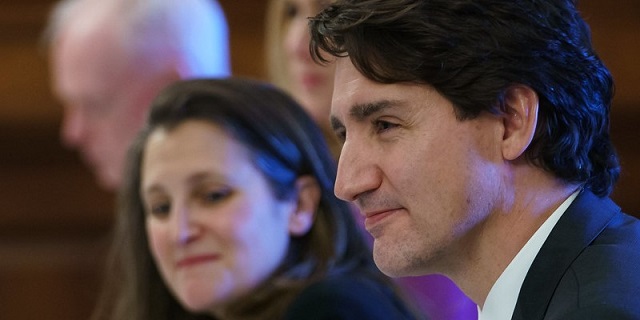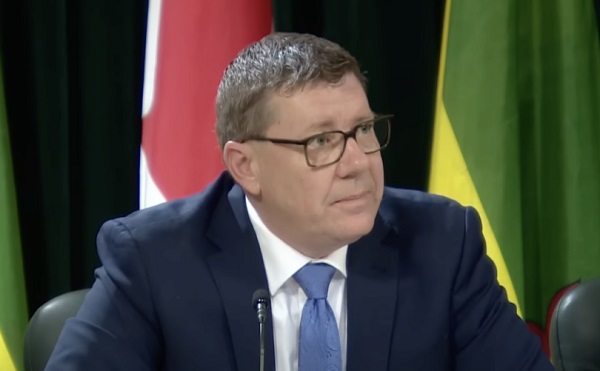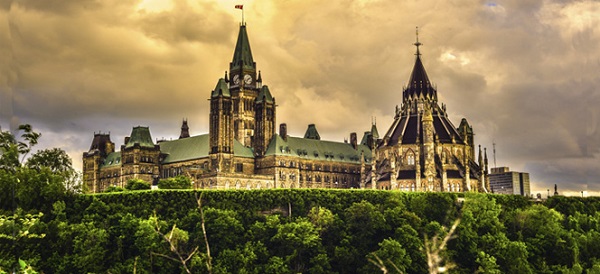Business
Federal government poised to pile on more spending and debt

From the Fraser Institute
Next week, the Trudeau government will release its fall fiscal update, which, considering the sorry state of federal finances, should demonstrate a newfound approach to spending and borrowing. But don’t hold your breath.
Although the Trudeau government describes itself as “fiscally responsible,” in reality it has a track record of unrestrained spending and large budget deficits. And it’s overseen the five highest years (2018 to 2022) of per-person program spending (adjusted for inflation) in Canadian history. Even excluding COVID-related spending, 2020 and 2021 remain the two highest years of per-person spending on record.
The Trudeau government has also run deficits every year since it took office in 2015—according to forecasts, this year’s deficit will eclipse $40 billion even though COVID is in the rearview mirror. Consequently, federal debt will have increased nearly $900 billion since 2014/15, up to $1.9 trillion for 2023/24.
While the prime minister and Finance Minister Chrystia Freeland often downplay the level of debt accumulation by noting that Canada has the lowest net debt-to-GDP ratio among the G7 countries (Germany, Italy, Japan, France, the United Kingdom and the United States), this is misleading.
Net debt is calculated as total (gross) debt minus all financial assets, with the implicit assumption that those assets could be used to offset debt. However, the Canada and Quebec Pension Plans (CPP and QPP) are included in the financial assets used to calculate net debt in Canada. But because CPP/QPP assets are needed for existing and future retirees, in reality they can’t be used to offset government debt.
Therefore, a better measure is gross debt, which measures all liabilities that require future payment of interest and/or principal by the debtor to the creditor. Compared to 29 other advanced economies, including the G7 countries, Canada’s gross debt as a share of the economy ranks 20th—meaning Canada is among the most indebted countries.
Clearly, the Trudeau government has been anything but fiscally responsible. And the current levels of spending and borrowing impose real costs on Canadians.
For example, since 2014/15 federal government debt interest costs have nearly doubled—reaching an estimated $43.9 billion, or 9.6 per cent of total revenues, for 2023/24. This means roughly one in every 10 dollars Ottawa collects from Canadian taxpayers this year will go towards debt interest costs, rather than government services or tax relief.
In light of these fiscal realities, if the Trudeau government wants to move anywhere close to a balanced budget in the foreseeable future, it must take meaningful steps in the upcoming fall fiscal update to restrain spending growth.
Unfortunately, this is unlikely to happen.
In a recent report, the Parliamentary Budget Officer (PBO) estimated that, due to spending increases, the federal government will run a deficit of $46.5 billion for 2023/24—$6.4 billion more than the government’s budget projections in March.
The government will also likely include new spending in the upcoming fiscal update meant to address housing and affordability. And will likely soon table legislation on national pharmacare, which the PBO estimates will cost $11.2 billion in 2024/25 alone.
Finally, not only does this unprecedented level of spending rack up mountains of debt, according to Bank of Canada Governor Tiff Macklem, “government spending is starting to get in the way of getting inflation back to target.” In other words, more spending by the federal government to address affordability concerns could actually worsen the problem by keeping inflation (and interest rates) higher than would otherwise be the case, eroding the purchasing power of Canadians.
While Ottawa’s fiscal situation demands a fiscally responsible fall fiscal update, it’s likely we’ll see much of the same next week from the Trudeau government—more spending and more borrowing.
Authors:
Business
Saskatchewan becomes first Canadian province to fully eliminate carbon tax

From LifeSiteNews
Saskatchewan has become the first Canadian province to free itself entirely of the carbon tax.
On March 27, Saskatchewan Premier Scott Moe announced the removal of the provincial industrial carbon tax beginning April 1, boosting the province’s industry and making Saskatchewan the first carbon tax free province.
Under Moe’s direction, Saskatchewan has dropped the industrial carbon tax which he says will allow Saskatchewan to thrive under a “tariff environment.”
“I would hope that all of the parties running in the federal election would agree with those objectives and allow the provinces to regulate in this area without imposing the federal backstop,” he continued.
The removal of the tax is estimated to save Saskatchewan residents up to 18 cents a liter in gas prices.
The removal of the tax will take place on April 1, the same day the consumer carbon tax will reduce to 0 percent under Prime Minister Mark Carney’s direction. Notably, Carney did not scrap the carbon tax legislation: he just reduced its current rate to zero. This means it could come back at any time.
Furthermore, while Carney has dropped the consumer carbon tax, he has previously revealed that he wishes to implement a corporation carbon tax, the effects of which many argued would trickle down to all Canadians.
The Saskatchewan Association of Rural Municipalities (SARM) celebrated Moe’s move, noting that the carbon tax was especially difficult on farmers.
“I think the carbon tax has been in place for approximately six years now coming up in April and the cost keeps going up every year,” SARM president Bill Huber said.
“It puts our farming community and our business people in rural municipalities at a competitive disadvantage, having to pay this and compete on the world stage,” he continued.
“We’ve got a carbon tax on power — and that’s going to be gone now — and propane and natural gas and we use them more and more every year, with grain drying and different things in our farming operations,” he explained.
“I know most producers that have grain drying systems have three-phase power. If they haven’t got natural gas, they have propane to fire those dryers. And that cost goes on and on at a high level, and it’s made us more noncompetitive on a world stage,” Huber decalred.
The carbon tax is wildly unpopular and blamed for the rising cost of living throughout Canada. Currently, Canadians living in provinces under the federal carbon pricing scheme pay $80 per tonne.
Automotive
Electric cars just another poor climate policy

From the Fraser Institute
The electric car is widely seen as a symbol of a simple, clean solution to climate change. In reality, it’s inefficient, reliant on massive subsidies, and leaves behind a trail of pollution and death that is seldom acknowledged.
We are constantly reminded by climate activists and politicians that electric cars are cleaner, cheaper, and better. Canada and many other countries have promised to prohibit the sale of new gas and diesel cars within a decade. But if electric cars are really so good, why would we need to ban the alternatives?
And why has Canada needed to subsidize each electric car with a minimum $5,000 from the federal government and more from provincial governments to get them bought? Many people are not sold on the idea of an electric car because they worry about having to plan out where and when to recharge. They don’t want to wait for an uncomfortable amount of time while recharging; they don’t want to pay significantly more for the electric car and then see its used-car value decline much faster. For people not privileged to own their own house, recharging is a real challenge. Surveys show that only 15 per cent of Canadians and 11 per cent of Americans want to buy an electric car.
The main environmental selling point of an electric car is that it doesn’t pollute. It is true that its engine doesn’t produce any CO₂ while driving, but it still emits carbon in other ways. Manufacturing the car generates emissions—especially producing the battery which requires a large amount of energy, mostly achieved with coal in China. So even when an electric car is being recharged with clean power in BC, over its lifetime it will emit about one-third of an equivalent gasoline car. When recharged in Alberta, it will emit almost three-quarters.
In some parts of the world, like India, so much of the power comes from coal that electric cars end up emitting more CO₂ than gasoline cars. Across the world, on average, the International Energy Agency estimates that an electric car using the global average mix of power sources over its lifetime will emit nearly half as much CO₂ as a gasoline-driven car, saving about 22 tonnes of CO₂.
But using an electric car to cut emissions is incredibly ineffective. On America’s longest-established carbon trading system, you could buy 22 tonnes of carbon emission cuts for about $660 (US$460). Yet, Ottawa is subsidizing every electric car to the tune of $5,000 or nearly ten times as much, which increases even more if provincial subsidies are included. And since about half of those electrical vehicles would have been bought anyway, it is likely that Canada has spent nearly twenty-times too much cutting CO₂ with electric cars than it could have. To put it differently, Canada could have cut twenty-times more CO₂ for the same amount of money.
Moreover, all these estimates assume that electric cars are driven as far as gasoline cars. They are not. In the US, nine-in-ten households with an electric car actually have one, two or more non-electric cars, with most including an SUV, truck or minivan. Moreover, the electric car is usually driven less than half as much as the other vehicles, which means the CO₂ emission reduction is much smaller. Subsidized electric cars are typically a ‘second’ car for rich people to show off their environmental credentials.
Electric cars are also 320–440 kilograms heavier than equivalent gasoline cars because of their enormous batteries. This means they will wear down roads faster, and cost societies more. They will also cause more air pollution by shredding more particulates from tire and road wear along with their brakes. Now, gasoline cars also pollute through combustion, but electric cars in total pollute more, both from tire and road wear and from forcing more power stations online, often the most polluting ones. The latest meta-study shows that overall electric cars are worse on particulate air pollution. Another study found that in two-thirds of US states, electric cars cause more of the most dangerous particulate air pollution than gasoline-powered cars.
These heavy electric cars are also more dangerous when involved in accidents, because heavy cars more often kill the other party. A study in Nature shows that in total, heavier electric cars will cause so many more deaths that the toll could outweigh the total climate benefits from reduced CO₂ emissions.
Many pundits suggest electric car sales will dominate gasoline cars within a few decades, but the reality is starkly different. A 2023-estimate from the Biden Administration shows that even in 2050, more than two-thirds of all cars globally will still be powered by gas or diesel.
Source: US Energy Information Administration, reference scenario, October 2023
Fossil fuel cars, vast majority is gasoline, also some diesel, all light duty vehicles, the remaining % is mostly LPG.
Electric vehicles will only take over when innovation has made them better and cheaper for real. For now, electric cars run not mostly on electricity but on bad policy and subsidies, costing hundreds of billions of dollars, blocking consumers from choosing the cars they want, and achieving virtually nothing for climate change.
-

 2025 Federal Election2 days ago
2025 Federal Election2 days agoJoe Tay Says He Contacted RCMP for Protection, Demands Carney Fire MP Over “Bounty” Remark
-

 2025 Federal Election2 days ago
2025 Federal Election2 days agoHong Kong-Canadian Groups Demand PM Carney Drop Liberal Candidate Over “Bounty” Remark Supporting CCP Repression
-

 2025 Federal Election2 days ago
2025 Federal Election2 days agoPoilievre To Create ‘Canada First’ National Energy Corridor
-

 2025 Federal Election2 days ago
2025 Federal Election2 days agoAlcohol tax and MP pay hike tomorrow (April 1)
-

 2025 Federal Election2 days ago
2025 Federal Election2 days agoChina Election Interference – Parties Received Security Briefing Days Ago as SITE Monitors Threats to Conservative Candidate Joe Tay
-

 2025 Federal Election2 days ago
2025 Federal Election2 days agoFixing Canada’s immigration system should be next government’s top priority
-

 2025 Federal Election1 day ago
2025 Federal Election1 day agoPoilievre, Conservatives receive election endorsement from large Canadian trade union
-

 Bruce Dowbiggin2 days ago
Bruce Dowbiggin2 days agoAre the Jays Signing Or Declining? Only Vladdy & Bo Know For Sure








